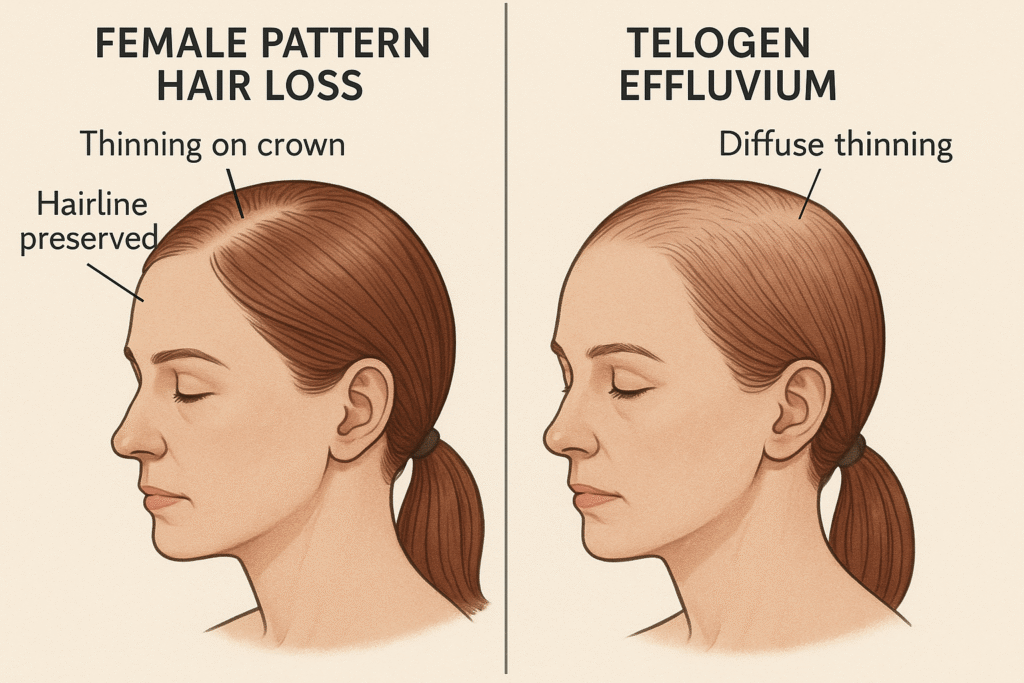What is Spironolactone For Hair Loss, and Why is it Used?
Spironolactone, a medication initially designed to treat high blood pressure and fluid retention, has emerged as a surprising ally in the fight against hair loss. While it might not be the first treatment that comes to mind, spironolactone’s unique ability to block androgens – male sex hormones – has made it a valuable tool for women experiencing certain types of hair loss, particularly female pattern hair loss (androgenetic alopecia).
This versatile medication offers a ray of hope for those who have struggled with thinning hair and sought effective solutions. Let’s delve deeper into how spironolactone works its magic on hair follicles.

Table of contents
- What is Spironolactone For Hair Loss, and Why is it Used?
- How Spironolactone Works: Understanding Androgens and Hair Loss
- Who Can Benefit from Spironolactone?
- Not a One Size Fits All Solution
- Benefits of Spironolactone for Hair Loss
- Dosage and Administration
- Potential Side Effects and Risks
- Precautions and Contraindications
- What to Expect When Using Spironolactone
- Combining Spironolactone with Other Treatments
- Alternatives to Spironolactone
- Conclusion: Is Spironolactone the Right Choice for You?
- Scientific Studies & Review Articles
- Other Resources:
- Hair Loss GP Related Links
How Spironolactone Works: Understanding Androgens and Hair Loss
To grasp how spironolactone combats hair loss, we need to understand the role of androgens. While primarily associated with men, women also produce androgens, albeit in smaller amounts. However, an excess of these hormones, or an increased sensitivity to them, can lead to a condition called androgenetic alopecia.
In this condition, androgens shrink hair follicles, causing hair to become thinner, shorter, and eventually stop growing altogether. Spironolactone steps in by binding to androgen receptors, effectively blocking the hormones from wreaking havoc on your hair follicles. This allows the follicles to recover and resume their normal growth cycle, leading to thicker, healthier hair.
Who Can Benefit from Spironolactone?
Spironolactone is most commonly prescribed for women experiencing female pattern hair loss. This condition is characterized by gradual thinning of hair on the top of the head, often leading to a widening part. However, spironolactone may also be beneficial for women with other types of hair loss related to hormonal imbalances, such as polycystic ovary syndrome (PCOS).
Not a One Size Fits All Solution
It’s important to note that spironolactone is not a one-size-fits-all solution. Its effectiveness can vary depending on the individual and the underlying cause of hair loss. Consulting with a dermatologist or endocrinologist is crucial to determine if spironolactone is the right treatment for you.

Benefits of Spironolactone for Hair Loss
When used appropriately, spironolactone can offer a range of benefits for women experiencing hair loss:
- Reduced Hair Shedding: By blocking androgens, spironolactone can significantly slow down or even stop hair shedding, allowing existing hair to remain on your head for longer.
- Stimulated Hair Growth: Spironolactone can help kickstart new hair growth by revitalizing dormant follicles and promoting the anagen (growth) phase of the hair cycle.
- Improved Hair Thickness and Density: As hair follicles recover and produce healthier strands, you may notice an increase in hair thickness and density, leading to a fuller appearance.
Dosage and Administration
The typical dosage of spironolactone for hair loss can vary depending on individual factors and the severity of the condition. Your doctor will determine the most appropriate dosage for you, which can range from 25mg to 200mg per day.
Spironolactone is available in both oral and topical forms. Oral spironolactone is generally considered more effective, but it can also carry a higher risk of side effects. Topical spironolactone is a newer option with potentially fewer side effects, but its effectiveness is still being studied.
Potential Side Effects and Risks
While spironolactone can be a game-changer for hair loss, it’s important to be aware of its potential side effects. Common side effects may include:
- Dizziness: This can occur, especially when you first start taking spironolactone or increase the dosage. It usually subsides as your body adjusts to the medication.
- Menstrual Irregularities: Spironolactone can affect your menstrual cycle, causing changes in flow, duration, or frequency.
- Breast Tenderness: Some women may experience breast tenderness or swelling.
In rare cases, spironolactone can cause more serious side effects, such as:
- Electrolyte Imbalances: Spironolactone can affect the levels of potassium and other electrolytes in your blood.This is why regular blood tests are often recommended during treatment.
- Liver Problems: Although rare, spironolactone can cause liver damage. It’s essential to inform your doctor if you experience any symptoms like jaundice (yellowing of the skin or eyes), abdominal pain, or dark urine.
Precautions and Contraindications
Spironolactone is not suitable for everyone. It’s contraindicated in individuals with:
- Kidney Disease: Spironolactone can worsen kidney function in people with pre-existing kidney problems.
- Addison’s Disease: This condition affects the adrenal glands, and spironolactone can exacerbate it.
- Pregnancy or Breastfeeding: Spironolactone can harm a developing fetus or nursing infant and should not be taken during pregnancy or breastfeeding.
Before starting spironolactone, it’s crucial to discuss your medical history and any current medications you’re taking with your doctor. They can assess your individual risk profile and determine if spironolactone is a safe and appropriate option for you.
What to Expect When Using Spironolactone
Patience is key when using spironolactone for hair loss. It’s not an overnight fix, and results typically take time to become noticeable. You may not see significant changes for several months, and it can take up to a year to see the full effects of treatment.
Timeline for Results:
- 3-6 Months: Initial reduction in hair shedding.
- 6-12 Months: Gradual improvement in hair thickness and density.
- 12+ Months: Continued improvement and potential for new hair growth.
Combining Spironolactone with Other Treatments
Spironolactone can be used alone or in combination with other hair loss treatments, such as minoxidil (Rogaine) or topical anti-androgen medications. Combining treatments may enhance their effectiveness, but it’s important to discuss this with your doctor to ensure a safe and appropriate approach.
Alternatives to Spironolactone
If spironolactone isn’t suitable for you or if you’re looking for alternative options, several other treatments are available for hair loss:
- Minoxidil (Regaine): This topical medication is available over-the-counter and works by increasing blood flow to the scalp and stimulating hair follicles.
Recommended Read
- Other Anti-Androgen Medications: Some prescription medications, like finasteride (Propecia), work similarly to spironolactone by blocking androgens. However, these medications are typically only used for men.
Recommended Read
- Natural Remedies: Some natural ingredients like saw palmetto, rosemary oil, and pumpkin seed oil may have hair growth benefits, but their effectiveness is often less well-established than prescription medications.
Conclusion: Is Spironolactone the Right Choice for You?
Spironolactone can be a valuable tool in managing hair loss, especially for women with androgenetic alopecia. While it offers promising benefits, it’s essential to weigh the potential risks and side effects, and to use it under the guidance of a qualified healthcare professional.
If you’re struggling with hair loss, don’t hesitate to seek professional advice. A dermatologist or endocrinologist can help you determine the underlying cause of your hair loss and recommend the most appropriate treatment options, including whether spironolactone is the right choice for you.
Spironolactone for Hair Loss: Frequently Asked Questions
Yes, spironolactone is primarily used to treat hair loss in women, particularly those with female pattern hair loss (androgenetic alopecia). This is because the medication targets androgens, which are male sex hormones, and these hormones play a different role in male pattern hair loss.
Patience is key when using spironolactone. It can take anywhere from 3 to 6 months to see initial results, and it may take up to a year to see the full effects. Hair growth is a gradual process, and consistency with treatment is crucial.
Some people experience mild hair shedding in the first few weeks of starting spironolactone. This is usually temporary and is a normal part of the hair growth cycle adjusting to the medication.
No, spironolactone should not be used if you are pregnant or planning to become pregnant. It can harm a developing fetus and should be discontinued if you become pregnant while on the medication.
If you experience any side effects, it’s important to contact your doctor. They can assess the situation and may adjust your dosage or recommend alternative treatments.
In most cases, spironolactone needs to be taken continuously to maintain its effects on hair growth. If you stop taking the medication, hair loss may return. Consult your doctor before making any changes to your treatment plan.
Insurance coverage for spironolactone can vary depending on your insurance plan and the reason for its use. It’s best to check with your insurance provider to determine if your treatment is covered.
Yes, spironolactone can be combined with other hair loss treatments like minoxidil (Regaine) or topical anti-androgen medications. However, it’s crucial to discuss this with your doctor to ensure a safe and effective approach.
Some natural ingredients like saw palmetto, rosemary oil, and pumpkin seed oil may have hair growth benefits. However, their effectiveness is often less well-established than prescription medications like spironolactone. If you’re interested in natural options, discuss them with your doctor to see if they might be a good fit for you.
If you miss a dose, take it as soon as you remember. However, if it’s almost time for your next dose, skip the missed dose and co
Disclamer
The information provided in these FAQs is intended for general informational purposes only and should not be considered a substitute for professional medical advice, diagnosis, or treatment. Always seek the advice of your doctor or other qualified healthcare provider with any questions you may have regarding a medical condition.
Do not disregard professional medical advice or delay in seeking it because of something you have read in these FAQs. If you think you may have a medical emergency, call your doctor or 999 immediately.
The information provided in these FAQs is not intended to diagnose, treat, cure, or prevent any disease. The use of any information provided in these FAQs is solely at your own risk.
External Sources
Scientific Studies & Review Articles
Clinical Studies:
- Efficacy of low-dose spironolactone for hair loss in women: (Journal of Drugs in Dermatology, 2024)
- URL: https://jddonline.com/articles/efficacy-of-low-dose-spironolactone-for-hair-loss-in-women-S1545961624P0e91X/
- This study investigated the effectiveness of low-dose spironolactone for women with female pattern hair loss.
- A pilot study evaluating the efficacy and tolerability of spironolactone versus finasteride in women with androgenetic alopecia: (International Journal of Dermatology, 2018)
Important Note:
Always consult with a qualified healthcare professional (such as a dermatologist or endocrinologist) before starting spironolactone or any other medication for hair loss. They can assess your individual needs, medical history, and risk factors to determine the most appropriate treatment plan for you.
Other Resources:
- Healthline – Spironolactone for Hair Loss:
- URL: https://www.healthline.com/health/spironolactone-for-hair-loss
- This article provides an overview of spironolactone for hair loss, including its benefits, dosage, and side effects.
- HairScience – Using Oral or Topical Spironolactone for Hair Loss:
- URL: https://hairscience.org/news/spironolactone-for-hair-loss/
- This article discusses both oral and topical forms of spironolactone for hair loss, including dosage and potential side effects.
- British Association of Dermatologists – Spironolactone leaflet:
- URL: https://www.bad.org.uk/pils/spironolactone/
- Drugs.com – Spironolactone (Aldactone):
- URL: https://www.drugs.com/spironolactone.html













